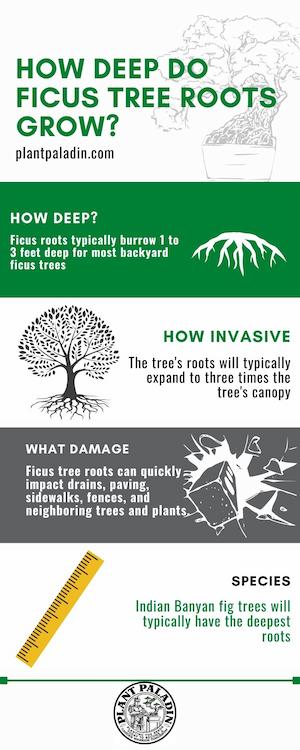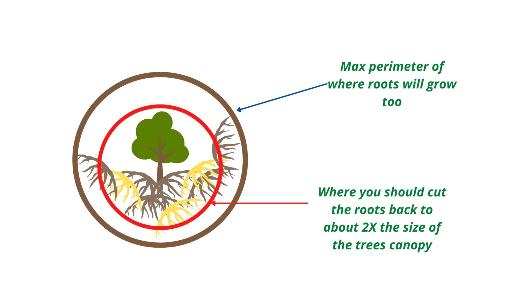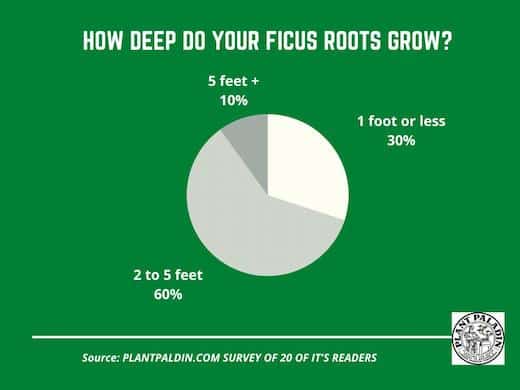This website is supported by its readers. If you click one of my links I may earn a commission. I am also a participant in the Amazon affiliates program and I will also earn a commission from qualified purchases.

One of the most versatile and common houseplants people keep both indoor and outdoor are Ficus trees. With over 800 species, you likely own one of these trees or know someone who does. With these trees being so commonplace, a question you will have if you are thinking of growing a Ficus is how deep do Ficus roots grow?
Ficus roots will only grow 2 feet deep for most Ficus tree species. Most Ficus trees will burrow between one and 3 feet deep if planted in the ground. Ficus trees can be much more invasive laterally, spreading their roots to over 50 feet.
So why do Ficus trees have shallow roots? And how easy is it to dig up these Ficus roots? Keep reading to find out more.
Just a quick heads up, over the past three years of running Plantpaladin, hundreds of people have asked for product recommendations. As such, You can find my favorite indoor bonsai tree here (link takes you to Bonsaiboy), my favorite outdoor bonsai tree (link takes you to Bonsaiboy), or have a look at all the products I recommend here.
How deep do Ficus roots grow
Ficus roots have a reputation for being invasive and fast growing (this tends to be with roots that spread out laterally rather than deep into the ground.)
A common question then that I had then before deciding if I should plant a Ficus tree in my backyard was precisely how deep Ficus tree roots would burrow.
After all, if these trees are destructive laterally picking up things like walls, pools, pavements, and sidewalks, what damage could they do deep underground.
To get to the bottom of this, I got in touch with a few tree experts and visited my local botanical gardens.
I even undertook a quick survey of 10 plant paladin readers.
To summarize:
- Ficus tree roots will not burrow or grow very deep underground.
- Most Ficus tree roots descend about one or two feet below the ground and have shallow roots.
- The problem with Ficus roots is how far these tree roots can spread laterally.
- Ficus roots will typically expand to about three times as wide as the size of the tree’s canopy.
- In more giant Ficus trees, this can be around 50 to 100 feet.
- Removing Ficus tree roots, even shallow ones on trees older than two or three years, is almost impossible as the tree roots strengthen very quickly.
- The only way to dig up roots is by killing the tree.
- Some Ficus trees will grow much deeper roots if grown in suitable environments in optimal conditions.
Let’s explore these points in more detail:

Which species of Ficus has the deepest roots?
Florida strangler fig, Indian Banyan, Brown Turkey, Moreton Bay Figs, Fiddle Leaf Figs, and Ficus Benjamin and Ficus Nitida are amongst the fastest growing species of Ficus and so will grow the deepest roots.
To summarize exactly how deep these roots can grow, I’ve put together a table with these species as well as a few other popular Ficus trees to give you an idea of how deep these roots can grow:
Species | Root depth |
Ginseng Ficus | 1 foot |
Florida Strangler Fig | 3 feet |
Brown Turkey | 2 feet |
Indian Banyan | 3 feet |
Moreton bay figs | 3 feet |
Fiddle leaf figs | 2 feet |
Ficus Benjamina | 3 feet |
Common Fig | 1 foot |
Sycamore fig | 1 foot |
What is the deepest a Ficus tree roots have gone?
So while most medium-sized Ficus trees grown in the ground in your backyard will have roots that are 1 to 3 feet deep ( while being a lot more expansive laterally, how deep are the world’s deepest Ficus roots?
After all, many of us will be growing Ficus trees, not in their native climates but much milder temperate climates.
While it is a characteristic of these trees to have far spreading lateral roots, do the giant trees also have shallow roots?
Even shallow roots have limitations when it comes to giant Ficus trees.
Look no further than a giant Indiana Banyan Ficus tree currently in India.
Located in a tiny corner of Anantapur District, this tree has the Guinness world record for being the largest tree in the world.
This tree has a canopy spreading 4.5 acres broad or a range of about 18,000 square meters.
If we were to use the invasiveness of the roots of this tree, we can assume that this tree would have a whopping root range of 54000 square meters.
Thankfully, as Ficus trees are shallow, these tree roots would not be that deep, spreading wide.
While there is no official information about how deep these giant tree roots go, we estimate that these tree rotos would burrow as deep as about 30 to 50 feet to support the massive tree.
So precisely how deep do Ficus roots grow?
Ficus roots will grow about 1 to 3 feet deep for most medium to large-sized Ficus tres outdoors. This is regardless of sub-species. Giant Ficus trees are grown in the wild in optimal conditions and still have shallow roots.
These giant trees then will have roots between ten and 25 feet deep.
Finding Ficus trees, however, with roots this deep is a rarity.
Ficus tree roots do, however, grow out laterally much more than they do downwards.
Are Ficus roots shallow?
All Ficus trees, regardless of subspecies, have shallow roots. Most Ficus tree roots typically only burrow between one and three feet deep. The shallow roots, however, mean that the roots expand rapidly laterally, causing damage to surrounding objects.
It’s easy then for these shallow roots to unearth sidewalks, drainpipes, and even foundations if not taken care of correctly.
Ficus tree roots will grow to about three times the size of the canopy of a tree laterally.

How deep do Ficus bonsai roots grow?
Ficus trees commonly used in Bosnia, such as Ginseng Ficus, also have shallow roots. These roots then only reach a few inches deep. Due to the miniaturization process, Ficus bonsai roots are less invasive than their regular-sized tree counterparts.
Why do Ficus roots not grow that deep
The biggest reason why Ficus tree roots do now grow that deep is because they expand out very wide.
You might think with shallow roots, Ficus trees will not be able to support themselves, but the truth is that by having a root system that can expand out more than three times the size of the canopy of a tree. It can spread its weight across a larger surface area.
However, this can lead to Ficus trees becoming invasive, so care needs to be taken when plating them, so they do not disturb surrounding items such as pipes, drainage, sidewalks, driveways, or pools.
On top of this, other trees can also be at risk if planted near a Ficus tree due to the expanding root system absorbing the nutrients from the soil from surrounding trees.
Are Ficus roots easy to rip up?
Ficus tree roots are not easy to dig up and can only be done during the first 2 to 3 years of a Ficus tree’s life. Removing Ficus trees older than this will become exponentially more difficult due to the roots toughening as they grow older.
Remove expensive Ficus roots or dig them up when they are young to prevent future problems.
I recommend plating your Ficus tree in a pot to prevent the root issue.
Planting in a pot means the root growth will be stunted and not impact surrounding areas or items.
Ensure, however, that you repot your Ficus tree once every two years to ensure the cramped roots don’t kill the tree.
Survey on how deep do Ficus roots grow?
Finally, I undertook a quick anecdotal survey of 10 plant paladin readers who grew Ficus trees and asked them how deep their Ficus trees’ roots grow.
Here are the results:

A lot of you reading this are also in the process of growing your ficus trees, so hopefully, the following table and posts will also be helpful:
Ginseng Ficus Bonsai tree Requirements | Explained |
Water | Once per day in the spring-summer or if kept indoors. Once per week if kept outdoors during the winter. Only water if dry to touch. |
Sunlight | 4 hours of direct sunlight in the summer. LED grow light can also be used. |
Temperature | Between 60 degrees F and 100 degrees F |
Fertilizer | Fertilize 18 times per year, twice per month between spring and summer. Once per month in the fall and winter |
Repotting | Once every 2 to 3 years in the first 10 years. You can then report once every 5 years |
Placement | Can be placed outdoors in direct sunlight or indoors in a bright spot. |
Wire type | Both copper and aluminum wire can be used. |
Time to grow from scratch into maturity | 8 to 12 years to reach full maturity |
Potting soil | An inorganic Akdama, volcanic ash soil mix works best. |
Growth type | Slow growing, averaging 3-5 inches per year |
Size | Average store-bought trees are size is one or two-handed bonsai trees - 3 to 10 inches in size, 2 to 8 inches wide |
Lifespan | 50 to 150 years |
Fruit | figs |
- Do Ficus trees grow in Florida?
- How to take care of a fake Ficus
- How to straighten a Ficus
- Do Ficus trees like coffee grounds?
- Is Ficus toxic to cats?
- Why is my Ficus turning yellow
- Do ficus trees have berries
- Do ficus trees have seeds?
My top picks for the gear you will need!
So like I mentioned earlier, over the past three years of running PlantPaladin, hundreds of people have asked me for my recommendations on the best bonsai gear on the market.
Having spent thousands of dollars on bonsai items these past few years and tested at least 100 bonsai-specific products, I’ve listed my favorite products below – All of which I highly recommend and think you can get great value.
They can purchase directly by clicking the link to take them to Amazon.
Bonsai Tool Set: One of the significant challenges I’ve had is finding a toolset that was not only durable but didn’t break the bank. SOLIGT has recently developed a fantastic bonsai tool set that covers all the tools you need to trim, prune, and repot your trees. – You can grab it here.
Complete Bonsai Set: Many of you will want to grow your bonsai trees entirely from scratch, but finding the varicose seeds, pots, and other items in one place can be challenging. Leaves and Sole then have created a complete bonsai set that I’ve personally used that ticks all the boxes. You can grab it here.
Bonsai wire: The number of times I’ve run out of wire for my bonsai or purchased cheap bonsai wire that doesn’t do the job is embarrassing for me to admit. After a lot of trial and error, I found that using Hotop’s aluminum bonsai wire is one of the best options on the market. This can easily be used for both indoor and outdoor bonsai. You can grab it here.
This post was written by Fehed Nicass who has been passionate about bonsai for over 3 years. He currently resides in the UK and works in sales.
